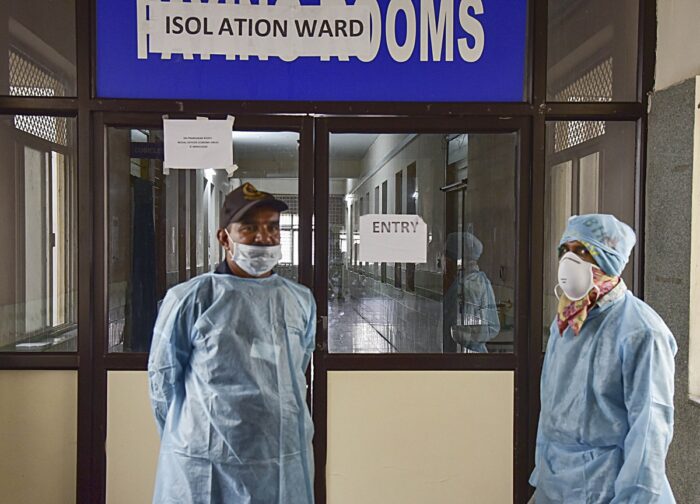
File Picture
The redeeming feature of India’s encounter with Coronavirus Pandemic since March 2019 is the Prime Minister Narendra Modi leading the nation from the front to stem its spread now and to overcome it by mobilising the will and resources of the nation. The Prime Minister termed it a ” social emergency” for the fact that a public health emergency calls for a social mobilisation to contain the Pandamic and eventually to eradicate it altogether. It’s heartening to see how the states have responded to the PM Modi’s call and strategised their actions within the framework of the national action plan to overcome the Pandemic ignoring for the present petty party politics. Having said that any discerning observer or analyst of the Indian response to the Pandemic cannot but ignore some hard facts about the country’s Health Sector and the environment in which it is functioning at present and the constraints on its performance.
Let’s look at the Constitutional provisions covering Health and communicable diseases: First, the subject of Public health and sanitation, hospitals and Dispensaries is in the State list of subjects (List 2. Entry no. 6); and under the Union List of the 7th Schedule there are only two entries – 28 and 81 dealing with “Port Quarantine, including hospitals connected therewith, seamen’s and marine hospital s ” and inter state Quarantine respectively. However under the List- 3 Concurrent list meaning subjects which could be taken up both by the union and the state governments there are a number of subjects / Entries which empower the Center to lead activities in Public Health Sector. Some of these are: Entry no 19,25 and 26 relating to Drugs, medical education ( which includes research) and medical profession. More importantly Entry no 29 on ” Prevention of the extension from one state to another of infectious or contagious diseases or pests affecting men, animals and plants” provides for a wide role for the Centre to formulate a national strategy and action plan on any public health issues of inter state nature either directly or indirectly. Presumably the Swachh Bharat Abhiyan has been launched as a nation wide program under this broad mandate as also Central funding of establishment of AIIMS ( All India Institutes of Medical sciences and Research) type institutions in different regions to upgrade the capability of the health care system.
However even a cursory look at the Constitutional provisions it would appear that the role envisaged for the union government in health care is not so very pronounced as ” public health, dispensaries and hospitals” is a state subject and action in this regard will be in the states and Districts. Nevertheless the Center has been taking a lead role in health and laid down the first National Health Policy in 1983,the second in 2002 and the Third National Health Policy in 2017.
Read together these policies reflect a continuity as the focus has been on expanding the facilities to provide” preventive and promotive health care” to” strengthen and trust of common man in public health care system”. However this would imply rapid expansion of the public health care system and supporting specialized health infrastructure. The policies lay down policy goals such as the 2017 policy goals of increasing the Life Expectancy at birth from 67.5 years to 70 years by 2025 or reducing the Infant and maternal mortality rates the maternal mortality rate is to be brought down to 100 per one lakh live births as per 2017 policy and 100 by 2020 or increasing health expenditure from the existing 1.5% of the GDP to 2.5% of the GDP by 2025 and reduction of the Total Fertility Rate per woman to 2.1 by 2025 and so on.
The policies are based on an integrated approach to health, family welfare, sanitation and provisioning of safe drinking water and clean environment. Under this policy several nation wide projects have been launched in the mission mode such as the ” Swachh Bharat Abhiyan ” and achieved a good deal of success. However lack of a synergy in these activities under different projects and agencies in the field resulted in widely varying outcomes in states leading to shortfall in utilisation of funds and hence the benefits.
In Kerala this synergy has been achieved in meeting the coronavirus crisis by coordinated efforts of local self governing institutions, departments, cooperatives, Women’s neighborhood groups and civil Societies including Church based social organisations . In an article entitled carried in the last Friday edition ( 17.04.20) of the Indian Express Isaac Thomas, Finance Minister Kerala mentioned that the transmission rate of coronavirus as well as recovery and mortality rates of coronavirus patients of Kerala have been 0.4% ,50% and 0.5% as compared to the national averages of 2.6% ,11% and 3.4%.respectively.
This success has been possible because the state health policy is integral to the Kerala model of development that Amartya Sen lauded as one oriented to ” human capability enhancement” with emphasis on health and education. In Kerala mapping of vulnerable areas, strengthening of the public health system by converting Primary health centres into Family health centres, investment of Rs 4000 cr in upgradation of health infrastructure by Kerala Infrastructure Investment Fund Board, creation of 57775 new posts have raised the capability of the state and the Society to manage the crisis. He underscored the role of multi level planning in this 28th year of People’s plan campaign in building up the capability.
Lack of such a synergy in the ground in varying degrees in other states explains the reasons for shortfall in utilisation of funds and realisation of physical targets. In a Statesman article dated 11.4.2020 Devendra Saxena pointed out that as against the 2019-20 Union Budget allocation of Rs 93035 crores for Health , the actual expenditure was much less- Rs 71584cr and utilisation of funds under Ayushman Bharat Pradhan Mantri Jan Arogya Yojana was low being Rs 3200 cr as against the allocation of Rs6400 cr. As a percentage of GDP the expenditure on health was estimated at only just half of a percent and if we include the expenditure incurred by states and the private health providers it would be about 1.2 % of the GDP well below 2017 level of 1.5% when the policy was made.
The New National Health Policy must be based on these experiences and not just a total of some mission projects and targets unrelated to the ground socio economic reality and capacity of the state field agencies to deliver. A health policy must be a long term one and based on solid foundation of science, political economy and social reality. Thus its premise must be a recognition of a serious market failure in health sector and that there will always be a conflict of interest between provisioning a ” public good” such as affordable health care and profit maximisation oriented private health care, insurance providers and pharmaceutical companies. The neo liberal market led model founded on profit cannot make socially efficient allocation of resources to create a ” public good” such as affordable health care for all or environmental security. This has been the American experience also which prompted President Barak Obama to push the Patient Protection and Affordable health care Act 2010- Obama care for posterity to make mediclaim policy and medication accessible to every US citizen.
Thus to bring about substantial improvement in public health care system on modern lines with provisions for health insurance the state has to put in place first of all, an upgraded health infrastructure by public investment and institutionalize the necessary synergy as in Kerala to provide health care for everyone. This would require redesigning the centre state relationships in health sector and funding patterns of health sector projects as a part of the policy.
Next, the policy should lay down a strong state role in drugs and pharmaceutical industry and revamp the Research and Development to revive the tradition of making vaccines laid down by great scientists like Sir PC Ray, “the father of Indian chemistry”who was instrumental in setting up in 1901 Bengal Chemicals in 1901 near Calcutta, the first Indian pharmaceutical company which produced Hydroxy chloroquine ,a drug that the US President Trump recently sought from India – rather desperately to meet the coronavirus Pandamic. It is now being realised across the world that production of Life saving drugs and pharmaceuticals are too critical for the well being of the country to be left to the private sector alone driven by profit.
The New Policy will have to remove the weakness of the domestic pharmaceuticals industry due to over dependence on import of Active Pharmaceutical Ingredients (API) from China by creating domestic capacity to produce API as in this area self reliance and not the economic efficiency makes sense in the larger interest of the nation. Revamping the activities of the Central Drug Research Institute, Lucknow and associated Research and Development institutions under a coordinated program to develop a domestic capacity to produce pharmaceuticals must be an important part of the New policy.
Finally the policy may lay down a road map to bring about a synergy between the health and environment policies and governance structures without which outcomes of the health policy would remain to a considerable extent unrealized and might even negate it.
This mutually supportive role of say improvement in air or water quality by successful pollution control measures resulting in better outcomes of public health care system is often lost sight of due to departmentalized approach to policy making . The new policy must address it suitably in the larger interest of sustainable development. As the nation is now united to meet the coronavirus Pandamic, it is the right time to act.
[the_ad id=’22723′]


















